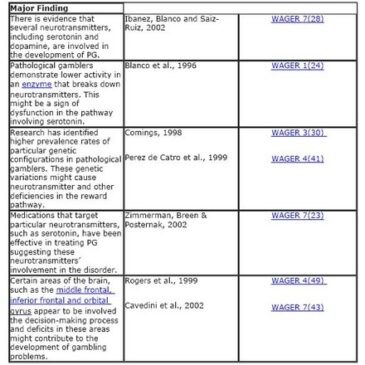Pathological gambling (PG) and sub-clinical gambling problems can be deconstructed into psychological, social and biological components. Initially, the majority of research on gambling disorders examined social and psychological aspects of the ailment. Recent progress in theory, research methods, and technology has allowed for important advances in research on biological factors that contribute to the development and persistence of gambling problems.
This week’s WAGER reviews some of the neurogenetic and neuroanatomical research reported in previous issues of The WAGER and introduces a special WAGER series on biological markers of addiction related to problem gambling. Neuropsychology is a challenging research topic, and we hope that The WAGER will provide readers with a useful and accessible summary of the most important findings in this field.
Central to many discussions of the neurobiology of addiction are the brain’s reward processing pathways and decision-making processes. The WAGER 3(34) introduced work by Blum et al. that described the cascade of neurological pathways involved in the brain’s processing of reward. When these pathways function correctly, one important end result is a release of dopamine, a neurotransmitter that can stimulate the experience of pleasurable feelings. Blum et al. hypothesized that individuals struggling with addiction, including pathological gamblers, have dysfunctional reward pathways. The authors termed this difficulty the reward deficiency syndrome. The causes of a reward deficiency syndrome are unknown; however, evidence suggests that particular genetic variations, extended use of a substance, or long-term stressors could prevent the reward cascade from functioning properly.
Deficits in some of the brain’s other functions also have been implicated in pathological gambling. For example, the somatic marker hypothesis suggests that individual differences in decision-making have biological roots (Damasio, 1995). Specifically, structures in the prefrontal cortex of the brain mediate the decision-making process. Neurobiological research has examined how deficits in these structures might reduce an individual’s ability to make informed decisions quickly, a circumstance which contributes to poor decision-making (see WAGER 4(34), for example).
Throughout the past decade, gambling researchers have produced evidence supporting both the involvement of a reward deficiency syndrome and decision making processes in pathological gambling. Table 1 summarizes some of the neurobiological findings associated with these models that The WAGER has discussed in the past. Readers can follow the links in the right hand column for a more detailed review of each topic.
Table 1. Selected Evidence of a Biological Component of Problem Gambling
The adoption of neurobiological research as a core component of gambling research has advanced the field of gambling studies into a new era. Researchers have gathered more evidence for neurobiological contributions since The WAGER featured the above studies. This exciting research provides answers to many questions about PG that cannot be addressed by other psychological research methods. This body of knowledge holds the potential to advance our collective understanding of many other behaviors that involve critical decision making with objects that stimulate both rewards and punishments. Importantly, understanding biogenetic influences does not reduce or remove our collective obligation to improve public policy and to accept responsibility for ourselves and others who develop disorders.
During the next few weeks, we will highlight several new studies that discuss key biological underpinnings of urges, addiction, non-specificity of addictions, and more. We recognize that this body of literature is difficult to understand without advanced training in the biological sciences. In this series, The WAGER will therefore strive to use clear, everyday language to explain this research and provide some insight into how these findings are changing our understanding of pathological gambling. We hope that you enjoy the forthcoming series: since all human behavior has biogenetic underpinnings, the information provided by this research is vital to an accurate and complete understanding of human behavior and addiction in general as well as problem gambling specifically.
Comments on this article can be addressed to Rachel Kidman
References
Damasio, A. R. (1995). Structure and functions of the human prefrontal cortex. In e. a. Holyoak (Ed.), Annals of the New York Academy of Sciences (Vol. 769, pp. 241-251). New York: New York Academy of Sciences.
The WAGER is a public education project of the Division on Addictions at Harvard
Medical School. It is funded, in part, by the National Center for Responsible
Gaming, the Massachusetts Department of Public Health, the Substance Abuse and
Mental Health Services Administration, and the Center for Substance Abuse
Treatment.





